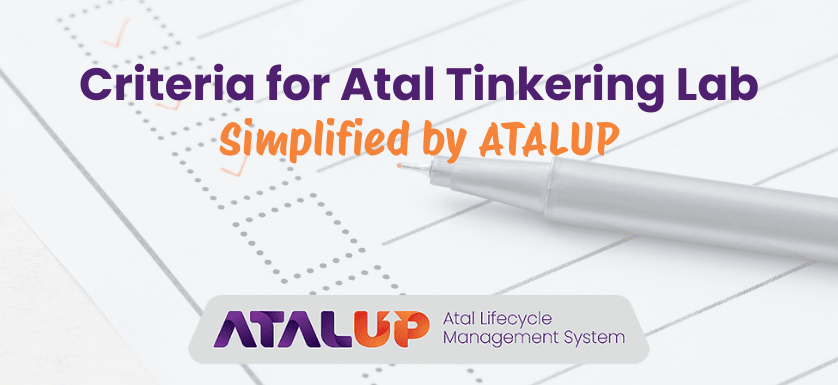
Schools can easily set up ATLs if they know the criteria for Atal Tinkering Lab. Atal Innovation Mission not only aims to set up an advanced STEM-based lab in every school in India but also wants schools to adopt futuristic teaching trends.
In the 2025 Union Budget, the government announced a plan to set up ATAL Tinkering Labs in 50,000 schools within the next five years. Each school will get an ATL grant of ₹20,00,000/-. The Indian government is trying to bring a revolutionary change in the education system and hence has intricate and broad eligibility criteria.
Let’s understand the criteria for Atal Tinkering Lab easily in a step-by-step approach.
Table of Contents
Criteria for Atal Tinkering Lab
1. Eligibility Criteria for Schools
Type of Schools Allowed
- Government schools (Central/State/Locally managed)
- Private schools run by registered trusts or societies
- Schools must be recognized by a State or Central education board
Classes Covered
- ATL is for students from Class 6 to Class 12.
Minimum Student Strength
- The school must have at least 200 students
2. Space and Infrastructure Requirements
Dedicated Lab Space
- The school must have a minimum 1,500 sq. ft. area for ATL (For northern hilly regions and islands, 1,000 sq. ft. is acceptable)
- The space must be well-ventilated, well-lit, and safe for conducting hands-on experiments
Basic Facilities
- The lab must have tables, chairs, electrical points, storage racks, and internet connectivity
- Safety measures like fire extinguishers and first-aid kits must be available
Equipment and Tools
The school must be ready to procure and maintain ATL-approved equipment, including:
- 3D printers
- Electronics and IoT kits
- Robotics kits
- Mechanical tools
- Sensors and measuring instruments
Schools can hire Atal Tinkering Lab vendors from GEM.
3. Financial Support and Utilization
Grant-in-Aid Amount
Schools receive a ₹20 lakh grant over five years
₹10 lakh for setting up the lab
₹10 lakh for operational costs (₹2 lakh per year for five years)
Utilization of Funds
- Schools must use the funds only for ATL-related expenses, including:
- Purchasing ATL equipment
- Organizing workshops, training, and student projects
- Maintaining and upgrading the lab
- Paying honorariums for external mentors and experts
4. Roles and Responsibilities of the School
ATL In-Charge
- The school must appoint a dedicated teacher to manage ATL operations
ATL Advisory Committee (AAC)
- The school must form a committee with:
- The Principal (Head of the Committee)
- ATL In-Charge (A science/maths/engineering teacher)
- Two subject teachers
- Two student representatives
- One industry expert/mentor (from academia/startups/corporates)
- One parent representative
Student Engagement
- Schools must ensure that a maximum students actively use the lab each year
- They must conduct regular ATL sessions, competitions, and exhibitions
- Schools must submit at least one mentoring report every month.
- Schools must support at least 10 student teams in participating in innovation marathons, competitions, and boot camps.
5. Application Process for Schools
Online Application Submission
- Schools must apply through the Atal Innovation Mission (AIM) portal
- Schools can take the help of platforms like ATALUP for end-to-end assistance.
Documents Required
- School Recognition Certificate from the education board
- Details of available lab space
- Undertaking by the school to comply with ATL guidelines
Selection and Approval
- AIM selects schools based on innovation potential, infrastructure readiness, and commitment
- Selected schools receive funding and must set up the lab within three months of fund disbursement.
6. ATL Lab Compliance and Reporting
Mandatory Reporting
- Schools must submit monthly reports on ATL activities, student participation, and fund utilization on the ATL Dashboard.
Performance Evaluation
- AIM reviews the school’s progress based on innovation projects, student engagement, and lab operations
Renewal of Operational Funds
- Schools must show active utilization of ATL resources to continue receiving annual operational grants
End-to-End Support in Fitting The Criteria for Atal Tinkering Lab
The government of India has designed extensive criteria for Atal Tinkering Lab. Schools must understand the criteria before applying to stand a chance of getting an ATL grant in 2025. Hence, ATALUP (Atal Lifecycle Management System) is assisting schools all over India.
Team ATALUP understands the importance of the grant and has built a team that assists schools in metro and rural areas. We have curated a simpler version of the criteria for FREE. A detailed list of all micro-guidelines can be downloaded from here. Contact us if you want any assistance in Atal Tinkering Lab setup from ATALUP.
Frequently Asked Questions
Can a school apply for an ATL grant if it already has a science lab?
An existing science lab does not affect eligibility. ATL is a separate innovation lab focusing on hands-on STEM learning.
Is there a deadline to apply for the ATL grant?
AIM opens applications periodically. Schools should check the Atal Innovation Mission (AIM) website for the latest updates.
Can multiple schools under the same trust apply for ATL grants?
Yes, multiple schools from the same trust can apply, but each school must meet the eligibility criteria separately.
Does AIM provide training for teachers managing ATL?
Yes, AIM offers teacher training programs and mentorship support to help educators effectively manage ATL activities.